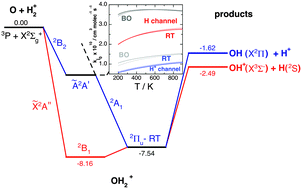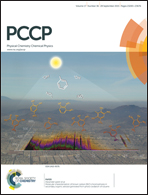Born–Oppenheimer and Renner–Teller coupled-channel quantum reaction dynamics of O(3P) + H2+(X2Σg+) collisions
Abstract
We present Born–Oppenheimer (BO) and Renner–Teller (RT) time dependent quantum dynamics studies of the reactions O(3P) + H2+(X2Σg+) → OH+(X3Σ−) + H(2S) and OH(X2Π) + H+. We consider the OH2+ ![[X with combining tilde]](https://www.rsc.org/images/entities/char_0058_0303.gif) 2A′′ and Ã2A′ electronic states that correlate with a linear 2Π species. The electronic angular momenta operators
2A′′ and Ã2A′ electronic states that correlate with a linear 2Π species. The electronic angular momenta operators ![[L with combining circumflex]](https://www.rsc.org/images/entities/i_char_004c_0302.gif) and
and ![[L with combining circumflex]](https://www.rsc.org/images/entities/i_char_004c_0302.gif) 2 are considered in nonadiabatic coupled-channel calculations, where the associated RT effects are due to diagonal VRT potentials that add up to the PESs and to off-diagonal CRT couplings between the potential energy surfaces (PESs). Initial-state-resolved reaction probabilities PI, integral cross sections σI, and rate constants kI are obtained using recent ab initio PESs and couplings and the real wavepacket formalism. Because the PESs are strongly attractive, PI have no threshold energy and are large, σI decrease with collision energy, and kI depend little on the temperature. The
2 are considered in nonadiabatic coupled-channel calculations, where the associated RT effects are due to diagonal VRT potentials that add up to the PESs and to off-diagonal CRT couplings between the potential energy surfaces (PESs). Initial-state-resolved reaction probabilities PI, integral cross sections σI, and rate constants kI are obtained using recent ab initio PESs and couplings and the real wavepacket formalism. Because the PESs are strongly attractive, PI have no threshold energy and are large, σI decrease with collision energy, and kI depend little on the temperature. The ![[X with combining tilde]](https://www.rsc.org/images/entities/char_0058_0303.gif) 2A′′ PES is up to three times more reactive than the Ã2A′ PES and H2+ rotational effects (j0 = 0, 1) are negligible. The diagonal VRT potentials are strongly repulsive at the collinearity and nearly halve all low-energy observables with respect to the BO ones. The off-diagonal CRT couplings are important at low partial waves, where they mix the
2A′′ PES is up to three times more reactive than the Ã2A′ PES and H2+ rotational effects (j0 = 0, 1) are negligible. The diagonal VRT potentials are strongly repulsive at the collinearity and nearly halve all low-energy observables with respect to the BO ones. The off-diagonal CRT couplings are important at low partial waves, where they mix the ![[X with combining tilde]](https://www.rsc.org/images/entities/char_0058_0303.gif) 2A′′ and Ã2A′ states up to ∼20%. However, VRT effects predominate over the CRT ones that change at most by ∼19% the BO values of σI and kI. The reaction O(3P) + H2+(X2Σg+) → OH+(X3Σ−) + H(2S) is probably one of the most reactive atom + diatom collisions because its RT rate constant at room temperature is equal to 2.26 × 10−10 cm3 s−1. Within the BO approximation, the present results agree rather well with recent quasiclassical and centrifugal-sudden data using the same PESs.
2A′′ and Ã2A′ states up to ∼20%. However, VRT effects predominate over the CRT ones that change at most by ∼19% the BO values of σI and kI. The reaction O(3P) + H2+(X2Σg+) → OH+(X3Σ−) + H(2S) is probably one of the most reactive atom + diatom collisions because its RT rate constant at room temperature is equal to 2.26 × 10−10 cm3 s−1. Within the BO approximation, the present results agree rather well with recent quasiclassical and centrifugal-sudden data using the same PESs.


 Please wait while we load your content...
Please wait while we load your content...